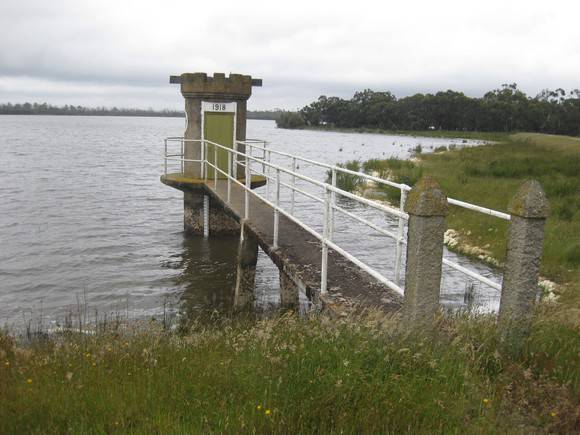| Back to search results » | Back to search page » |
|
Geelong Waterworks
Other NamesStony Creek Water System , Geelong's First Permanent Major Water Supply Works LocationGEELONG VIC 3220 - Property No B7410
File NumberB7410LevelState |
|
Statement of Significance
What is significant? The Geelong Waterworks (also known as the Stony Creek Water System), was built by the Victorian Water Supply Department to bring water to the Town of Geelong and commenced operation in 1873. In 1872 the local catchment area to the Stony Creek Reservoir covering some 1,560 hectares was reserved by the Government to be managed for water supply purposes and to protect it from the impacts of gold mining, timber cutting and other activities. Control of that area was subsequently vested in the Geelong Waterworks & Sewerage Trust. The principal works include the embankment of the Upper Stony Creek Reservoir No.1, which was one of the world's highest earthen dams at the time of construction; the Anakie Aqueduct, incorporating tunnels and flumes, built in difficult country along the ranges on the western slopes of Stony Creek; the concrete dam forming the Lower Stony Creek Reservoir that has been recognised as Australia's first mass concrete gravity dam; the pipeline through the Anakie Gorge from Lower Stony Creek Reservoir, requiring construction of a number of creek crossings and several tunnels through ridges; and the Lovely Banks Basins and associated structures. The headworks and catchment area of the Stony Creek System now lie within the Brisbane Ranges National Park. Why is it significant? The Geelong Waterworks has Aboriginal, historic, scientific, and social significance. How is it significant? The Geelong Waterworks has historic significance as the first permanent major water supply works serving Geelong and is among the earliest water supply systems constructed in Victoria. The system played a significant role in facilitating the development of Geelong to City status by 1910 and subsequently as an important manufacturing centre and port. It provided Geelong's only source of water supply for over 50 years and continued to operate in its entirety until the 1980's. Significant people associated with the Geelong Waterworks include Henry O. Christopherson, engineer, proposer of the original scheme and later Chief Engineer of the Victorian Water Supply Department; George Gordon, design engineer of the Lower Stony Creek concrete dam; Lieutenant-Colonel Richard H. Sankey, engineer, engaged by the Victorian Government to review the Geelong Scheme in 1871; Edward Dobson, Resident Engineer of the Geelong Water Supply Works; Charles Brown - Victorian Water Supply Department inspector for the Anakie district; and James S. Sharland, Engineer-in-Chief of the Geelong Waterworks & Sewerage Trust. The Geelong Waterworks has scientific significance. The works, which were constructed over a period of seven years from 1866 to 1873, demonstrate original design qualities of the nineteenth century. Considerable engineering design and construction problems were surmounted in order to bring the system into operation. The dam forming the Lower Stony Creek Reservoir, completed in 1874, has been recognised as Australia's first mass concrete gravity dam. The headworks and catchment area of the Stony Creek System lie within the Brisbane Ranges National Park which contains flora and fauna of State significance and two statutory Reference Areas that are used to maintain natural ecosystems. There are also many Aboriginal Places of State significance within the Stony Creek catchment area. There are 46 places registered on the Victorian Aboriginal Heritage Register, 3 scarred trees and 43 artefact scatters. The locations are Cowie Creek, Anakie Hills, Brisbane Ranges, Stony Creek and Stony Creek Reservoirs. Classified: 26/06/15
Group
Utilities - Water
Category
Water Supply Precinct




